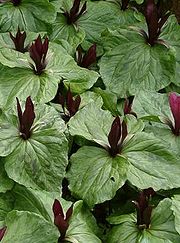Trillium chloropetalum: Difference between revisions
Jump to navigation
Jump to search
Created page with '{{SPlantbox |familia=Trilliaceae |genus=Trillium |species=chloropetalum |habit=herbaceous |habit_ref=Flora - A Gardener's Encyclopedia |Max ht box=20 |Max ht metric=in |height_r…' |
No edit summary |
||
| Line 1: | Line 1: | ||
{{SPlantbox | {{SPlantbox | ||
|familia=Trilliaceae | |familia=Trilliaceae | ||
|genus=Trillium | |genus=Trillium | ||
|species=chloropetalum | |species=chloropetalum | ||
|habit=herbaceous | |habit=herbaceous | ||
| Line 22: | Line 22: | ||
|min_zone=6 | |min_zone=6 | ||
|max_zone=9 | |max_zone=9 | ||
|image= | |image=TrilliumChloropetalumRubrum-thumb.jpg | ||
|image_width= | |image_width=180 | ||
}} | }} | ||
'''''Trillium chloropetalum''''' is a [[spring (season)|spring]]-flowering [[perennial plant]] native to the west and north-west coast of the [[United States]]. Common names: '''Common Trillium''', '''Giant Trillium''', '''Giant Wake Robin''', and '''Sessile Trillium'''. | |||
Color is variable, often dark red to white. A typical [[Monocotyledon|monocot]], it has leaves and flowers that are grouped in threes. It is clump-forming and prefers a shady habitat, since its natural habitat is the woodland floor. | |||
==Cultivation== | ==Cultivation== | ||
Latest revision as of 16:18, 1 May 2010
| Trillium chloropetalum subsp. var. | ||||||||||||||||||||||||||||||||||||||||||||||||||||||||
|---|---|---|---|---|---|---|---|---|---|---|---|---|---|---|---|---|---|---|---|---|---|---|---|---|---|---|---|---|---|---|---|---|---|---|---|---|---|---|---|---|---|---|---|---|---|---|---|---|---|---|---|---|---|---|---|---|

|
|
| ||||||||||||||||||||||||||||||||||||||||||||||||||||||
| ||||||||||||||||||||||||||||||||||||||||||||||||||||||||
Trillium chloropetalum is a spring-flowering perennial plant native to the west and north-west coast of the United States. Common names: Common Trillium, Giant Trillium, Giant Wake Robin, and Sessile Trillium.
Color is variable, often dark red to white. A typical monocot, it has leaves and flowers that are grouped in threes. It is clump-forming and prefers a shady habitat, since its natural habitat is the woodland floor.
Cultivation
Propagation
Pests and diseases
Varieties
Gallery
-
photo 1
-
photo 2
-
photo 3
References
External links
- w:Trillium chloropetalum. Some of the material on this page may be from Wikipedia, under the Creative Commons license.
- Trillium chloropetalum QR Code (Size 50, 100, 200, 500)
